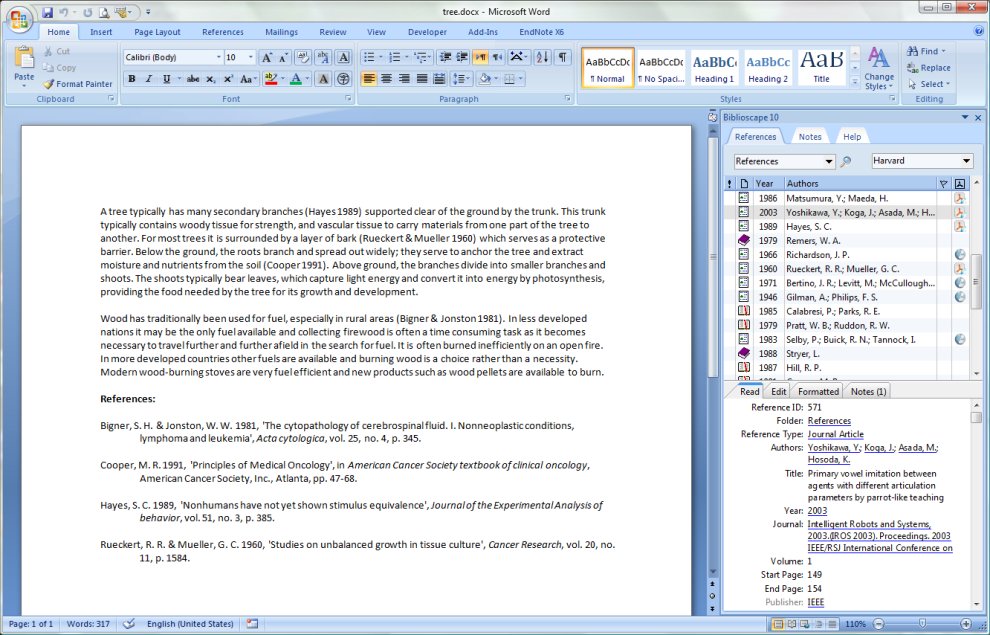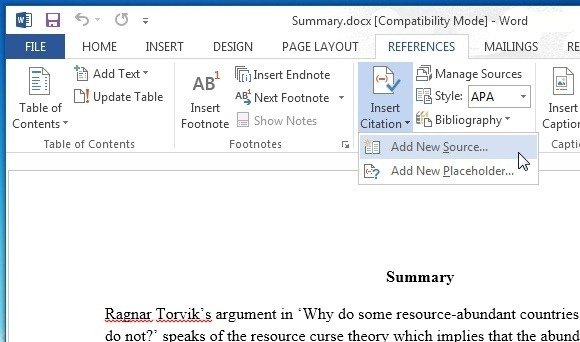

In APA style, two citations are used to cite a source:
#Citing sources in word manual#
For more information, please consult the Publication Manual of the American Psychological Association, 7th ed. This APA Citation Guide provides the general format for in-text citations and the reference page. Love a good plugin? There is even a range of WordPress plugins specifically designed to help with source citing and attribution, including Simple Attribution, Attribution 2000, and Open Attribute.APA (American Psychological Association) style is most frequently used within the social sciences, in order to cite various sources. Pay attention to what other bloggers are doing, and figure out which attribution method best suits the style of your blog. One style of attribution might stand out for you, or you may play with a range of source-citing options until you find one that fits.
#Citing sources in word software#
In a recent blog post, WP Themes offered this suggestion for bloggers stuck for image ideas: “Crack out some coloured pencils or your kid’s paint set if you’re really feeling inspired, but creating your own art for your blog can be as easy as opening up one of the pre-loaded software programs on your computer, or downloading a free version.”.WP Themes suggests creating your own art to compliment your blog posts.If you can’t find the right image to accompany your blog post, why not create your own art?.For example, if this post were discussing the copyright of images, and had used the WP Themes post (Legally) sourcing images for your blog as a resource for ideas on image creation, we may cite that source one of the following three ways: Some bloggers simply link a relevant phrase back to the original content, while others include a hat-tip to the author, or an attributed quote. There are no hard and fast rules when it comes to attribution. It’s a win-win! So how do you go about citing your sources? This is a significant distinction, and generally means you are welcome to report and discuss ideas and facts in your own words.Ĭlear as mud? When all else fails, use your common sense, and err on the side of caution.Īttribution is all about giving credit where credit is due – and providing your readers with a greater experience by offering them more information. A common rule of thumb when considering whether a quote is substantial, is that quality is deemed more important than quantity.Īnother important note about copyright is that it only applies to the material form of an idea, fact or style – not the actual idea, fact or style itself. ‘Quoting’ does not give you, or anyone else, permission to copy and paste entire paragraphs. It’s pretty vague, but trust your intuition on quotes.

Generally speaking, you can use quotes that may not be considered a substantial part of the original work, with substantial being defined as essential, distinctive or important. This is of particular importance if you want to quote sources and ideas on your blog. There are a number of exceptions to copyright infringement – chiefly use that is considered ‘fair use’ or ‘fair dealing’ for the purposes of criticism, review, parody, research and reporting. It applies to literary works such as books, articles, song lyrics and blog posts artistic works like paintings and graphic art as well as films, sound recordings, and a whole host of other creative works.
#Citing sources in word plus#
The duration of copyright is generally for the lifetime of the creator, plus an additional 70 years, and in most countries copyright protection is automatic – meaning copyright automatically applies as soon as a work is created. And it’s blog-savvy to direct your readers to more information.Īlways assume that the works of others are protected by copyright, until you are able to confirm otherwise. It’s good mojo to link back to their site or original article. If you’re discussing someone else’s works or ideas, it’s polite to recognise them as a source.

Citing your sources is just good blogging etiquette. But it’s not just a matter of following the law and avoiding punishment for sneaky deeds online… like passing someone else’s ideas off as your own (which, by the way, is a big no-no). As blogging and online forms of writing and disseminating information have become more popular, the so-called ‘grey area’ of how copyright law applies to contemporary online spaces has come under greater legal scrutiny.īloggers have been legally pursued, and at times prosecuted, for copyright infringements and defamation.

Are you citing sources for your blog? Giving a shout-out to the bloggers who have paved the way for your latest post with other great resources? Offering your readers more quality information?īlogging is commonly considered an informal space – but that doesn’t mean the rules of copyright don’t apply.


 0 kommentar(er)
0 kommentar(er)
